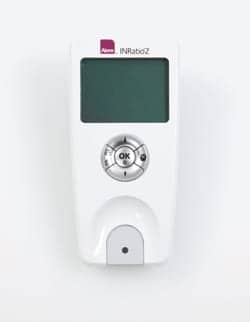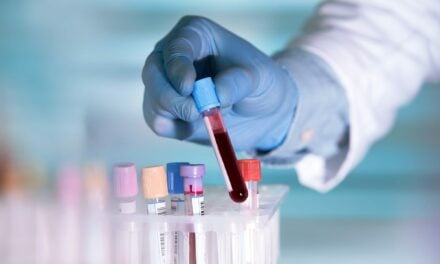Taking testing beyond physician’s offices and outpatient clinics

Roche’s handheld CoaguChek® XS system for point-of-care coagulation monitoring uses a drop of blood from a fingerstick and provides PT/INR results in about 1 minute.
Fast and accurate coagulation test results are critical to controlling day-to-day hemostasis and assuring adequate clotting time during emergency medical procedures. Point-of-care (POC) and self-test technology have improved the field of coagulation testing for the past 2 decades. There are several new products on the cusp that may increase POC’s share of the coagulant testing market. This article looks at issues faced by today’s clinical coagulation laboratory professional, popular POC coagulant testing, and upcoming coagulant analyzers and technologies.
POINT-OF-CARE APPLICATION
“POC testing may not be appropriate for all coagulation monitoring scenarios, but it can play a role to closely and accurately monitor a patient’s anticoagulant status,” says Larry J. Smith, PhD, (ASCP)CM, laboratory director at Memorial Sloan-Kettering Cancer Center, New York, and a member of the American Society for Clinical Pathology (ASCP). “In particular, POC has been shown to be a viable option for monitoring warfarin therapy, as it is very easy to perform, and we have a great deal of experience with it.”
A clinical driver for POC testing, particularly for warfarin, is the limited knowledge of many general practitioners on how to manage coagulant therapy and the scarcity of dedicated clinical coagulation laboratories nationwide. People who take warfarin and rely completely on visits to the clinical laboratory or specialist’s office are often monitored via a “yo-yo method.” In this situation, the patient presents a high prothrombin time (not clotting fast enough) at the visit, so the health care provider discontinues or lowers warfarin therapy until the next visit. Eventually, the patient’s clotting time will significantly decrease, leading the provider to reinstate or increase warfarin therapy. This cycle is repeated over and over again until a stable INR is reached.
CURRENT POC OPTIONS FOR COAGULANT MONITORING
In the area of coagulation testing, peer-review reports and meta-analyses show that POC appears to be at least as good as and possibly better than conventional management in highly selected patients. Also, treatment-related patient satisfaction and quality of life improve in patients monitoring their own anticoagulation.
A recently published study examines the use of POC coagulation analyzers in the early treatment of stroke patients. Specifically, the researchers looked at POC testing for the International Normalized Ratio (INR) in the emergency department (ED) as a time-saving alternative to the same test done in the central hospital laboratory, thereby reducing time to treatment. The researchers found that POC testing in the ED did indeed save valuable time in testing patients admitted for stroke.

“POC [point of care] testing may not be appropriate for all coagulation monitoring scenarios, but it can play a role to closely and accurately monitor a patient’s anticoagulant status. In particular, POC has been shown to be a viable option for monitoring warfarin therapy, as it is very easy to perform, and we have a great deal of experience with it.”
— Larry J. Smith, PhD, (ASCP)CM, lab director at Memorial Sloan-Kettering Cancer Center, New York
TODAY’S POC COAGULATION ANALYZERS
Below find a sampling of the POC coagulation analyzers available in the marketplace:
CoaguChek® systems from Roche Diagnostics, Indianapolis, offer health care professionals and their patients on warfarin therapy a simple, fast, and convenient way of monitoring clotting time. The line of handheld monitors consists of four models, including one for patient self-testing. All of the monitors require a drop of blood from a fingerstick for the test, and provide INR results in about 1 minute. The systems enable the physician to monitor whether the patient is in the target therapeutic range. Studies by Wurster and others have shown that using point-of-care PT/INR testing as part of a patient-centered approach to care know as systematic anticoagulation management may help improve the time patients are in therapeutic range and reduce the risk of adverse events, thus helping to improve patient outcomes.
The Point of Care CoaguSense PT/INR monitoring system from Abbott Point of Care, Princeton, NJ, measures actual time required for clotting. It is a portable system that directly detects clotting end point; emulates the World Health Organization (WHO) reference tilt-tube method; uses fresh capillary whole blood; and displays prothrombin time results in about 1 minute.
The Alere INRatio®2 PT/INR Monitoring System from Alere Inc, Waltham, Mass, measures clotting time using a modified version of the one-stage PT test. It is the only monitor on the market that runs two quantitative controls with every patient test on a single drop of whole blood, in about a minute, according to the company.
The ITC ProTime® Microcoagulation System from ITC, Edison, NJ, provides two levels of reagent control that automatically run with each patient; internal instrument checks verify optical, electrical, and mechanical functions; sensitive thromboplastin reagent (ISI = 1.0), as recommended by the American Heart Association (AHA), the College of American Pathologists (CAP), and WHO; results in less than 5 minutes; 16-hour, room-temperature, open-pouch stability of bar-coded cuvette; accepts and stores patient/operator ID; automatically sends test results to printer, computer, and/or laboratory information system; and onboard and external controls.
THE FUTURE

The ITC ProTime® Microcoagulation System provides two levels of reagent control that automatically run with each patient.
Rapid coagulation testing provides critical information on a patient’s clotting time. Laboratory coagulation testing is also big business. It is estimated to be the fifth largest market in professional diagnostics worldwide, representing approximately $1.3 billion in sales in 2010 and having a projected annual growth rate of 5.1% over the next 5 years. Biotechnology companies and manufacturers are investing heavily into developing high-tech solutions for the future.
Below are some items at different locations in the coagulation-testing pipeline—from prelaunch to concept development:
POC COAGULATION PLATFORM
Siemens Healthcare Diagnostics, Tarrytown, NY, and Universal Biosensors, Victoria, Australia, are planning to launch an advanced POC coagulation platform composed of a series of novel, handheld POC coagulation testing systems that incorporates opposing electrode technology from Universal Biosensors and Siemens’ advanced coagulation testing solutions, says Gian Sachdev, senior manager of public relations, Siemens Healthcare.
The technology platform will use a new electrochemical cell that can be adapted for multiple analytes and provides for enhanced measurements in whole blood. The first solution scheduled for release is a prothrombin time test. Additional products with enhanced menus and extended capabilities are anticipated over time.
ROCHE EXPANDS INTO CENTRAL LAB COAGULATION TESTING
Late last year, Roche announced plans to expand its coagulation testing product line in North America beyond physician’s offices and outpatient clinics with the development of a full line of coagulation analyzers for hospital and reference labs. The new line, which will be marketed under Roche’s cobas® brand, is expected to include three platforms to address a range of customer needs, from low-volume testing to the high-throughput demands of commercial laboratories, along with a complete menu of coagulation assays. Roche expects to introduce the new line in the United States and Canada in 2014, subject to regulatory approval and other requirements.
Roche also recently announced the acquisition of Verum Diagnostica, which specializes in platelet function testing, and a strategic alliance with Technoclone, a reagent specialist in thrombosis and cardiovascular diagnostics, to help support the market entry. “This initiative represents a significant move into a new market in the US and a strategic commitment to the laboratory coagulation market globally for Roche,” says Randy Pritchard, vice president of marketing at Roche Diagnostics Corp. “The comprehensive coagulation portfolio in development for hospital and reference labs will complement our existing handheld products for patient self-testing and point-of-care testing by health care professionals. The goal is to be able to provide solutions across the continuum of patient care.”
LAB ON A CHIP
For the past few years, lab-on-a-chip (LOC) technology has been a buzzword in the field of clinical pathology. LOCs are small devices (measuring a few millimeters to a few centimeters) that can complete one or more assays with a very small volume of sample and reagent. LOCs provide advantages over traditional assays, including faster results due to short diffusion distances, lower cost due to small sample and reagent volumes, and potential portability because of their small size.
Researchers at Dublin City University, Dublin, Ireland, published research on their development of a fluorescent method for detecting microscopic blood coagulation on a microconstructed lateral flow platform. This assay was shown to be capable of measuring the effect of heparin concentration on blood clotting time from 0 to 1.5 U mL-1.
VALIDATION ASSAYS

The Alere INRatio®2 PT/INR Monitoring System runs two quantitative controls with every patient test on a single drop of whole blood, in about a minute.
Many coagulation assays are coming on to the market, but there is a dearth of validation assays for these newly approved diagnostics, Smith says. To incorporate new therapies into the lab, health care professionals need more information about the treatments and assays to ensure a patient’s coagulation status is constantly maintained, he says. Validation assays and antidotes to reverse a drug’s effect are often not provided because they are, in most cases, not needed, he says. However, there are circumstances when the close monitoring of a coagulant drug is required, such as when a patient’s blood is thinned to a point where emergency surgery could lead to hemorrhagic shock, and an antidote is needed to bring prothrombin time/INR back to normal.
CONTINUING EDUCATION
Continuing education is a huge priority for clinical pathology lab professionals, Smith says. The field is constantly and quickly evolving—new technologies and analytical methods are being introduced at a rapid pace, while others are being phased out due to lackluster performance. ASCP’s education programs range from disease-specific to general pathology issues.
A past program covered heparin-induced thrombopenia (HIT) and how to monitor coagulation and treat patients with this disease. HIT is a syndrome associated with the development of thrombocytopenia due to the administration of heparin. Although somewhat rare, it has a 20% to 30% mortality rate. This seminar details alternative nonheparin therapies and monitoring strategies.
Peer-reviewed publications also play a large role in the continuing education of coagulation lab professionals. Smith cites the following as particularly useful:
King CR, Porche-Sorbet RM, Gage BF, et al. Performance of commercial platforms for rapid genotyping of polymorphisms affecting warfarin dose. AJCP. 2008;129:876-883. This reference recommends health care professionals should check a patient’s genotype if the patient is not responding to warfarin treatment.
Lehman CM, Frank EL. Laboratory monitoring of heparin therapy: Partial thromboplastin time or anti-xa assay? Lab Medicine. 2009;40:47-51. Lehman and Frank cover the use of partial thromboplastin time and chromogenic assays for monitoring warfarin levels.
Sunderji R, Gin K, Shalansky K, et al. Clinical impact of point-of-care versus laboratory measurement of anticoagulation. AJCP. 2005;123:184-188. This was an important study on the use and reliability of POC devices. Patients using anticoagulation POC monitors were told to regularly test the systems against laboratory methods to monitor performance. The INR can vary between test systems owing to different instrument-reagent combinations. The study found acceptable agreement between the two methods, but a small rate of INR agreement suggests external quality control systems might be clinically important.
CONCLUSION
Outcome studies have proven that POC testing has resulted in a reduction in blood loss and transfusion requirements, cost, and complication rates. It has also improved timely patient care and clinical outcomes, as well as reduced the length of patients’ hospital stays.
The future is bright for the field of coagulant therapy. New drugs and technologies promise more accurate and timely testing and hemostasis control. Researchers and manufacturers should make efforts to include validation assays and antidotes in their pipelines.
Care should also be taken by clinical lab professionals to stay current with emerging therapies and technologies. With so many media options for continuing education, there is no reason why a coagulation therapy provider or technician should not be well-versed in the state of the art.
Sarah Michaud is a contributing writer for CLP.




